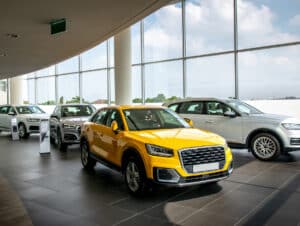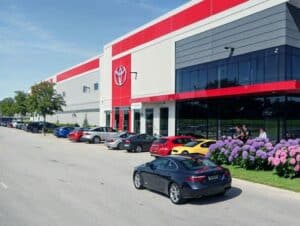Automotive leaders don’t lack effort. They lack a platform that connects the work. Imports. Distribution. Retail. Service. Warranty. Finance. HR. Marketing. The list is long, and the tools are often disconnected to meet today’s automotive retailing demands. The result is duplicated work, slow decisions, and uneven customer experiences.
A365 exists to fix that. It’s Annata’s automotive platform built on Microsoft Dynamics 365, Azure, Copilot, Power Platform, and Dataverse. It replaces fragmented stacks with one environment that unifies enterprise resource planning, customer relationship management, and dealer operations. Below is what that means in real terms for an importer, a distributor, or a dealer group that needs clarity, control, and growth when it comes to automotive retail.
- Vehicle and lifecycle management that’s complete and auditable
A365 tracks every vehicle from order to end of service life. Orders flow from importer to distributor to automotive retailer with one record of truth. Logistics milestones are captured as events. The system records specification, options, pricing, incentives, and compliance steps. When a vehicle moves from yard to showroom to customer delivery, the status changes are visible to sales, service, and finance at the same time.
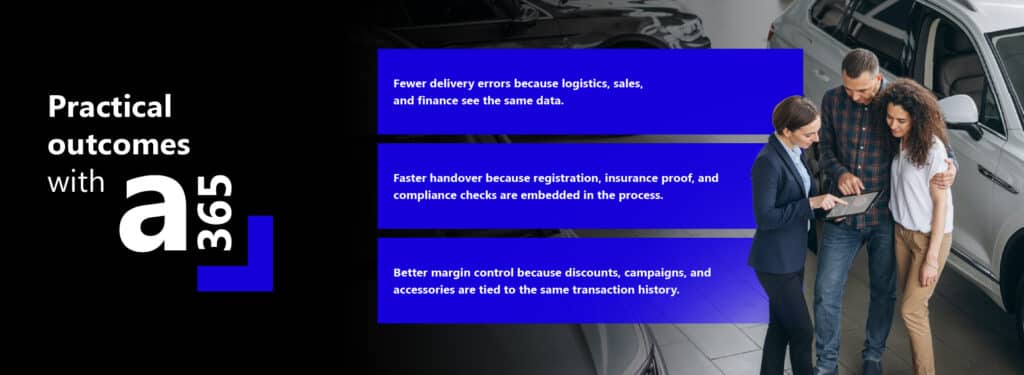
- Service and aftersales that protect margin and loyalty
Service is where many automotive retailers make or lose their year. A365 brings planning, reception, workshop, warranty, and parts into a single queue. Capacity planning uses technician skills, bay availability, and promised times in one schedule. Job cards, service history, and warranty eligibility are visible without leaving the workbench. Copilot helps advisors and controllers with suggestions, summaries, and quick drafts of customer communication.
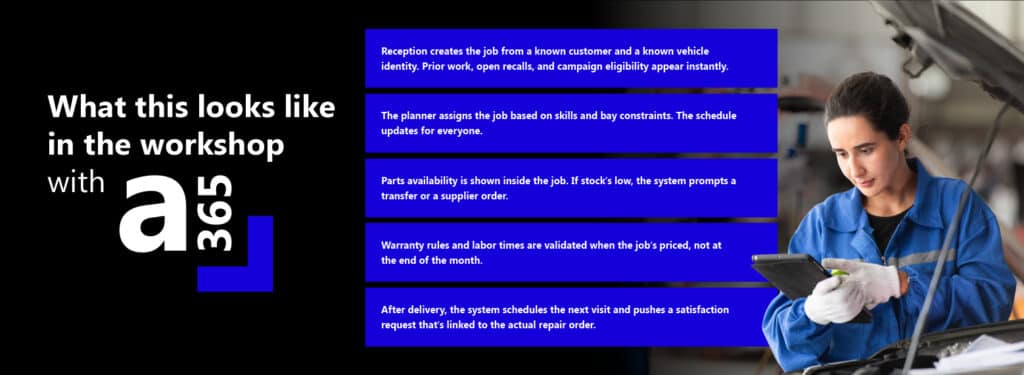
KPIs to watch inside A365
- Technician utilization and efficiency by day and by model line.
- First-time fix rate and the parts back-order effect on cycle time.
- Warranty approval time and recovery rate.
- Net promoter score tied to the specific visit and the advisor.
- Parts and inventory that move with demand
A365 connects demand signals from sales and service to stocking policy. Reorder points, economic order quantities, and supersession are calculated with live data. When a service campaign launches or a model line ages, the system shifts stocking logic. Obsolescence is monitored and parts teams get early prompts for returns or transfers.

- Sales and digital automotive retail without swivel-chair work
Sales teams work in one place for lead capture, quoting, finance, and delivery. A365 stores the full customer journey and uses Copilot to surface the next best action. Configure, price, and quote happen with current stock and costs. Finance approvals feed straight into the deal. When the handover’s complete, the customer record’s already ready for service and parts. No duplicate entry. No import and export files.
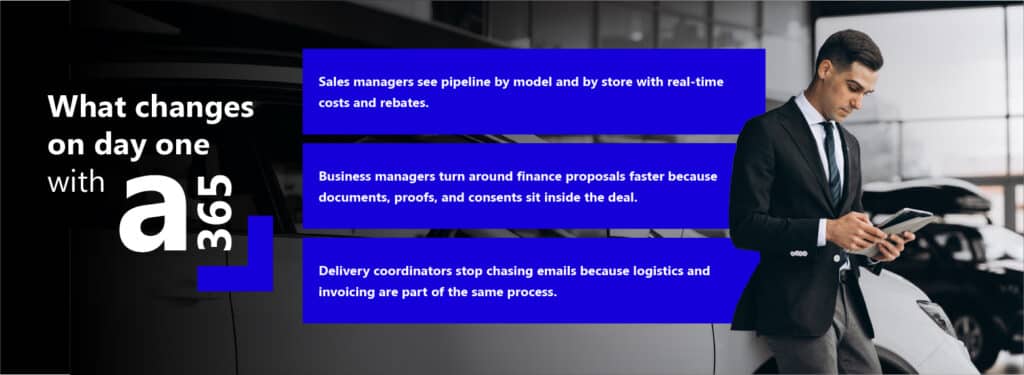
- Finance, procurement, and HR that live in the same system as operations
A365 includes the enterprise backbone. General ledger, accounts receivable, accounts payable, fixed assets, budgeting, and procurement aren’t side systems. They run in the same data model as sales and service. That means a sale, a warranty recovery, a supplier credit, and a payroll journal all post with the right dimensions and the right audit trail.

- CRM and customer engagement that feel personal
A365 unifies contact history, consent, vehicles, quotes, repairs, and campaigns. You can target owners of a specific model with a specific repair pattern. You can exclude customers who have already booked. You can measure revenue that came from a message, not just opens and clicks. Copilot drafts messages and summarizes interactions so advisors and sellers spend time with people, not screens.
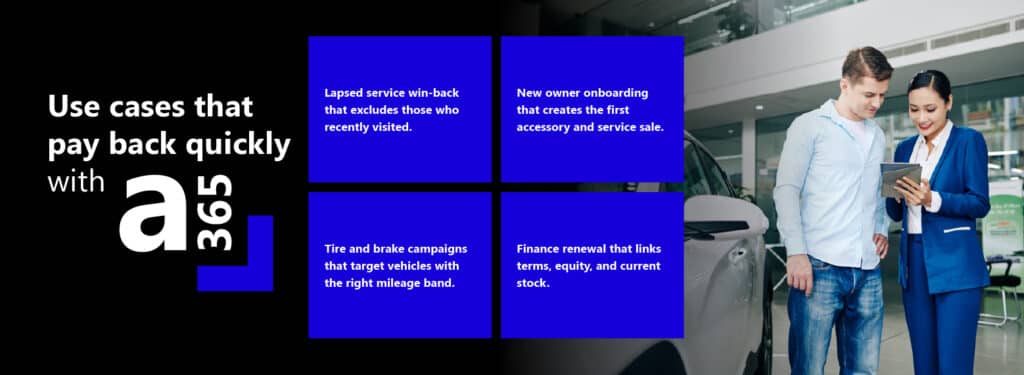
- Data, analytics, and AI that are built in
Because A365 sits on Dynamics 365 and Dataverse, the data’s already modeled for analytics. Power BI dashboards ship with the solution and can be extended without starting from zero. Copilot answers natural language questions. Managers ask for the top causes of repeat repair on a model and see the job lines and parts that drive it. Leaders ask which stores convert inspection recommendations at the highest rate and view the advisor behaviors behind that result.
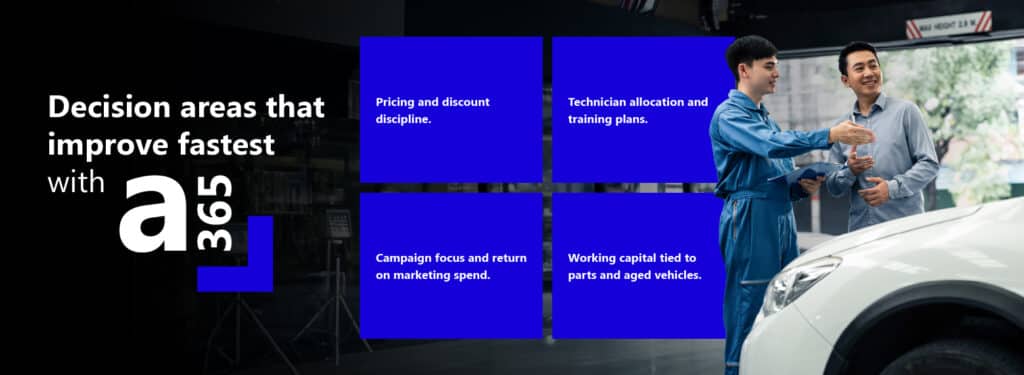
- Security, compliance, and governance that satisfy auditors
The platform inherits Microsoft security features. Identity, role-based access, environment isolation, and encryption are standard and not bolted on. Approval chains and document control create an audit trail that stands up to internal and external review. Privacy management helps teams honor consent and retention policies without manual lists.
- Integration that respects the ecosystem
Automotive runs on networks. A365 integrates with OEM portals, finance houses, logistics providers, and data hubs through connectors and APIs. The goal is straight-through processing where possible and clean handoffs where not. Importers and distributors can keep specialist tools where they add value and still run a single core.
- Migration and adoption that reduce business risk
Annata delivers a repeatable path off legacy systems. Discovery aligns processes with standard A365 capabilities. Data migration uses templates for vehicles, customers, inventory, and ledgers. Change management trains by role with model-driven apps that match daily work. Cutover’s staged and supported with hypercare so stores don’t lose momentum.
What makes A365 different from a generic stack for automotive retail
A365 isn’t a general business system with a few automotive labels. It’s shaped by people who’ve run dealerships, importer networks, and service centers. Workflows reflect technician rosters, multi-brand complexity, and the realities of warranty and recall. Annata invests a large share of revenue into research and development and maintains a prototype lab that trials artificial intelligence and predictive methods against real service and automotive retail scenarios. The platform stays current. Your teams stay productive. Your investment stays evergreen.
Why this matters now
Customers expect digital automotive retailing experiences that are simple and accurate. OEM programs and direct-to-consumer models are changing the automotive retail role. Vehicles are becoming data sources that can request service, download updates, and confirm completion. None of this works well on a stack of disconnected tools.
A365 gives importers, distributors, and retailers a single platform for growth. It connects people, processes, and data from pre-sales to after-sales. It reduces vendor sprawl. It shortens the time between idea and execution. It provides leadership with a clean view of margin, risk, and opportunity.
Your next step
A365 turns complexity into clarity. It lets your teams move faster with confidence. It gives your customers a connected automotive retail experience that will keep them coming back.
Want a session that maps your current processes to A365 capabilities? Connect with us or visit the A365 Digital Experience Center to explore industry scenarios related to automotive retail.






